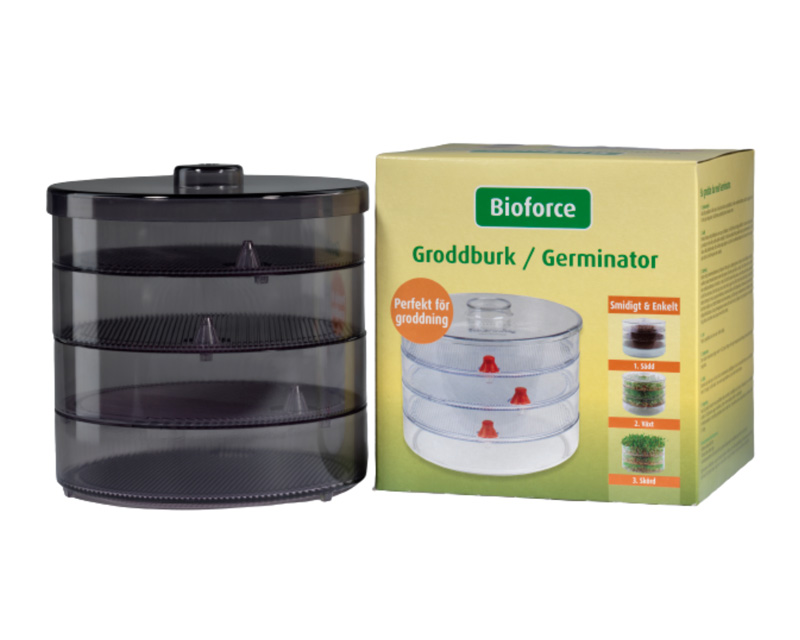Sprouting container BIOFORCE GERMINATOR
A triple-layered germ box where you can grow three different types of seeds at the same time and enjoy a variety of fresh sprouts!
How to germinate:
1. Preparation: wash the container in cold water. Do not dry out the inside of the germ box. The red venting caps should be tight, but not too tight. Wash the seeds thoroughly under running water.
2. Sowing: When germinating very small seeds, place a moist sheet of seed paper on the shelf. Distribute the seeds according to the recommendations on the seed bag. If the seeds are larger, no seed paper is needed. Make sure the seeds are not too close together. Seeds can be germinated on a single shelf or on several shelves at once. To ensure that fresh sprouts can be harvested every day, we recommend that you grow the seeds at intervals. After sowing, the layers are spread so that the red ventilation caps are not directly on top of each other, but slightly offset from each other.
3. Watering: water according to the recommendations on the seed bag. Rinse the entire vessel with the lid open under running lukewarm water or rinse each shelf separately. Pour water into the top plate until the red aerator cups are completely covered – at least 5 dl – and until the water starts to flow. All floors are now automatically irrigated. Wash the seeds thoroughly before germination, once the sprouts have germinated, keep the bottom shelf moist. Excess water will flow through the ventilation holes in the bottom shelf and down into the bottom panel. The water level can be lowered by tilting the entire container, which also prevents flooding. Make sure there is no excess water in the tank. Depending on the growing conditions, the ripening process may differ from that described on the seed bag. Mature sprouts with a clearly glossy surface simply need to be sprinkled with fresh water.
4. Light: Place the germination box in a bright spot, but out of direct sunlight.
5. Temperature. Higher or lower temperatures can lengthen or shorten the germination period.
6. Harvesting: Depending on the type of seed sown, room temperature, lighting and the specific needs of each seed, you can harvest the sprouts in 3-8 days. Harvesting – to avoid damaging the roots, gently pull out the sprouts or cut them off the seed paper.
7. Cleaning: After harvesting all sprouts, the sprout box must be thoroughly washed. It can be washed in the dishwasher, but we recommend that you place it upside down, as more heat is emitted from the bottom of the dishwasher. We recommend washing the sprouts before eating. If you don’t plan to eat the sprouts right away, they will keep in the fridge for 2-3 days.
If the seeds do not germinate:
– the seeds are too tightly packed
– seeds are not well watered
– the room temperature is too high or too low (optimum temperature for germination is 18-22°C).
– seeds other than those specially bred for germination are used.
– Unfavourable conditions such as too much water around the seeds, too much or too little watering, inappropriate temperature or light can cause mould. Grey mould has a pungent smell and should not be confused with fine roots.
Orientation container dimensions: height 15,5 cm, diameter 20 cm.
The colour of the east container may differ from the one shown in the photo.
-
-
-











